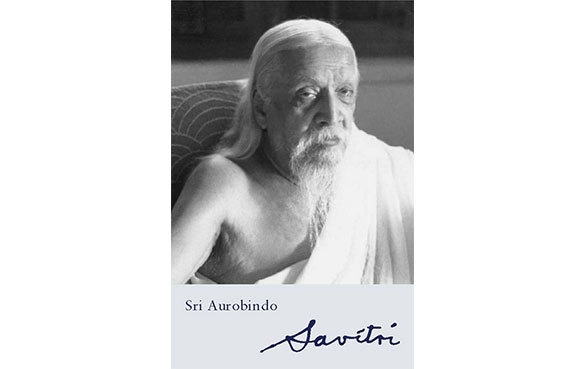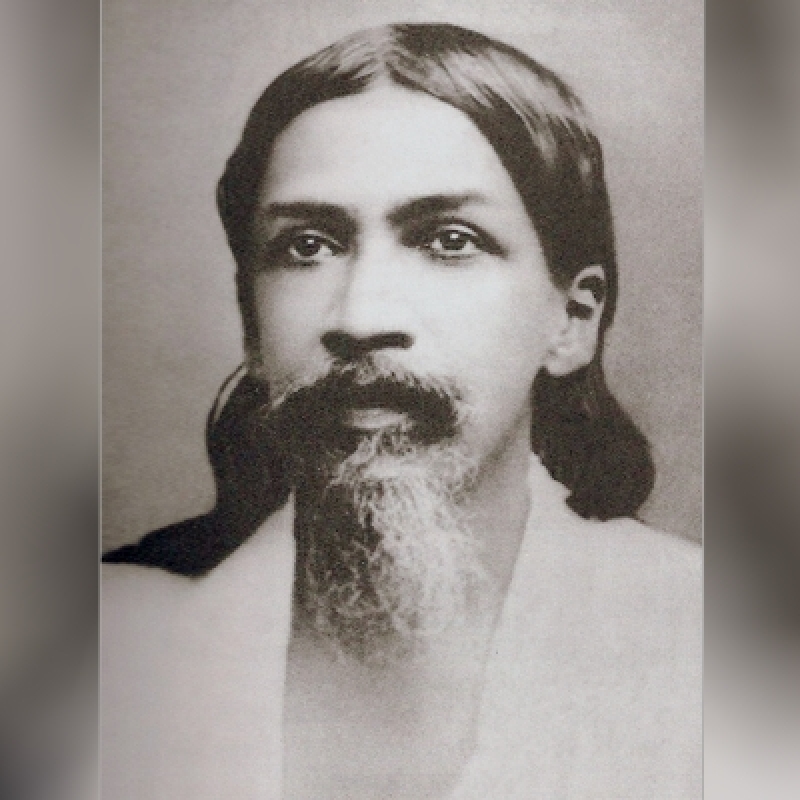To read Sri Aurobindo’s poem Savitri is to witness a tremendous adventure in the interior realms; to witness and participate in a multidimensional quest. It is perhaps the best example of spiritual verses—poetry as dhyana mantra. This Indian epic, as we find, is Aurobindo’s magnum opus. (Photo courtesy: Wikimedia Commons)
Sri Aurobindo, born Aurobindo Ackroyd Ghose (1872–1950), developed certain specific spiritual practices that afforded him experiences in the interior spaces of the soul. His poem Savitri: A Legend and a Symbol constitutes an evocative multidimensional map of such transformative encounters. Running into 12 books and 49 cantos, Savitri[1] is the longest poem in the English language, and the poet consistently worked on it for close to five decades. Taking off from a small anecdote in the Mahabharata, this poem is cast as a legend and a symbol—the entire text is an unfolding of the image of aesthetic transformation in symbolic terms.
Aurobindo was a prolific writer whose work ranged from political pamphlets to sociological treatises; from exegeses on the Vedas, the Upanishads and the Bhagavad Gita to systematic treatises on yoga and its various dimensions; from critical thinking on the foundations of Indian culture and history to philosophical writings on the meaning of spiritual being and the poetics of spiritual transformation.
Also read | The Practice of Translation in India
According to him, all life is yoga, the integration of inner and outer nature—a union that would progressively spiritualise all beings. In philosophical terms, consciousness is ‘everything that exists’, and there is a gradual evolution from the material (the inconscient state in ‘Aurobindian’ terminology) to the self-conscious and spiritually ‘superconscient’ (a state above the consciousness). He designated specific hierarchies of the mind, such as ‘Higher Mind’, ‘Illumined Mind’, ‘Intuition’ and ‘Overmind’—stages to be reached before achieving the complete divinisation of all beings (matter inclusive) in the ‘Supramental’ being.[2] Poetry, as he saw it, worked as an index of the evolving consciousness.
Listen | The Mother reading Book 1 of Sri Aurobindo's Savitri
The poem revolves round the symbolic dimensions of its characters and their experiences. The tale of Satyavan and Savitri is simple enough. The king of Madra, Aswapathy, has a daughter, Savitri, who falls in love with the Salwa prince Satyavan, the son of a dispossessed and blind king Dyumatsena. It is foretold that Satyavan is to die within a year of their marriage. Savitri is undaunted and they are married. When Satyavan dies at the destined time, Savitri awaits Yama (the lord of death) to come and take possession of his soul. She follows the soul into the nether realms. Despite her repeated requests, Yama is unrelenting in granting her the life of Satyavan. Nevertheless, she persists and is finally able to overcome death with her perseverance and single-minded commitment. Satyavan is finally reunited with Savitri in a life of eternal happiness.

The text of Savitri is replete with unique instances of the power of the word from its very opening. Here is how the poet depicts the slow movement of the trio—Satyavan, Death and Savitri—into the realms of the beyond:
Luminous he moved away; behind him DeathWent slowly with his noiseless tread, as seen
In dream-built fields a shadowy herdsman glides
Behind some wanderer from his voiceless herds,
And Savitri moved behind eternal Death,
Her mortal pace was equalled with the god's.
Wordless she travelled in her lover's steps,
Planting her human feet where his had trod,
Into the perilous silences beyond.[3]
Also read | On Archiving and Translating Mahatma Gandhi's Works
The mantra, or the highest intensity of poetic expression, according to Aurobindo, is reached when sound and sense (sabda and artha) combine in the right order, as it happens in the following instance where the nuances of the language are captured:
Only sometimes small thoughts rose and fell
Like quiet waves upon a silent sea
Or ripples passing over a lonely pool
When a stray stone disturbs its dreaming rest.[4]
And again:
As blooms a flower in an unvisited place
The wide world knew not yet the inhabitant flame,
Yet something deeply stirred and dimly knew;
There was a movement and a passionate call,
A rainbow dream, a hope of golden change;
Some secret wing of expectation beat,
A growing sense of something new and rare
And beautiful stole across the heart of time.[5]
To read Savitri is to witness a tremendous adventure in the interior realms; to witness and participate in a multidimensional quest. Because Savitri is cast in the mould of epic poetry or mahakavya, the requisite state of mind is one of openness and humility, similar to that of prayer. Each word and each phrase should ring in a ‘solitude and an immensity’, be heard in the ‘listening spaces of the soul’ and the ‘inner acoustic space’, and be seized by the deeper self when the mantric evocations come into effect.
In The Future Poetry, Sri Aurobindo writes:
To embellish life with beauty is only the most outward function of art and poetry, to make life more intimately beautiful and noble and great and full of meaning is its higher office, but its highest comes when the poet becomes the seer and reveals to man his eternal self and the godheads of its manifestation. [6]
And this highest function is what he has achieved in this work.
This article was also published in The Indian Express.
Read the full poem here.
Notes
[1] Savitri: A Legend and a Symbol was first published in 1950–51. The extracts cited here are from the tenth impression, published in 1984.
[2] ‘Higher Mind’, ‘Illumined Mind’, ‘Intuition’, ‘Overmind’, and ‘Supermind’ are grades of ‘Overmental’ becoming according to the scheme of Sri Aurobindo. See his The Life Divine (Pondicherry: Sri Aurobindo Ashram Trust, 1982).
[3] Sri Aurobindo, Savitri: A Legend and a Symbol (Pondicherry: Sri Aurobindo Ashram Trust, 1984), 577.
[4] Ibid., 543.
[5] Ibid., 367.
[6] Sri Aurobindo, The Future Poetry (Pondicherry: Sri Aurobindo Ashram Trust, 1983), 243.













